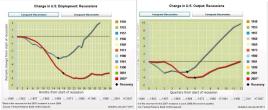When comparing the Obama economy and the Reagan economy, I often used a database from the Minneapolis Federal Reserve that compared jobs and growth data during business cycles.
 That made sense since both presidents had an economic expansion that began relatively early in their tenures.
That made sense since both presidents had an economic expansion that began relatively early in their tenures.
But what about comparing Obama and Trump? The Minneapolis Fed data isn’t overly useful since we’re in the same expansion that began during the Obama years.
To avoid that methodological problem, some people have been comparing the final years of the Obama Administration with the early years of the Trump Administration.
Let’s do the same thing using the just-released jobs data from the Bureau of Labor Statistics. The unemployment rate is only 3.7 percent, which is certainly good news. But the employment-population ratio is a better gauge of the real strength of the jobs market.
But those numbers don’t tell us much. They’ve been improving during the Trump years, but not in a way that seems different than the trend that was underway in Obama’s final years.
What about if we look at income data instead of employment data?
The Wall Street Journal has an editorial comparing the fate of workers under both administrations.
Time to wake up from the Barack Obama economy, folks, and admit how many more Americans are prospering from the faster economic growth and tighter labor market after the
policy changes of 2017. …the economic expansion reached its 10th anniversary, the longest on record. But the accounts ignore that the last two years have been far different than the first eight in economic policies and results. We’re long enough into the Trump era to track the differences. ……Average hourly earnings for production-level manufacturing workers have grown at an annual rate of 2.8% during the Trump Presidency compared to 1.9% during Barack Obama’s second term.
The WSJ shares data on income growth in key states, and it certainly seems that Trump deserves bragging rights.
The WSJ also argues that Trump’s policies have been beneficial for minorities.
The jobless rate for blacks is 6.2%, which is only 2.9 percentage-points higher than for whites versus a 4.6 percentage-point difference before the start of the 2008 recession. Unemployment has fallen twice as much among blacks as whites since December 2016. Nearly one million more blacks and two million more Hispanics are employed than when Barack Obama left office, and minorities account for more than half of all new jobs created during the Trump Presidency. Unemployment among black women has hovered near 5% for the last six months, the lowest since 1972, and a mere 3.5% of high school graduates are unemployed. …The Trump Administration…policy mix of deregulation and tax reform has unleashed more private investment and job creation that has lifted productivity and wages for the non-affluent. The result has been faster growth and less inequality.
All this is positive news, but I’m not quite as hopeful about Trump’s policies as the WSJ.
The numbers are accurate, though I’m not sure whether we should give all the credit to Trump since it would be more accurate to say that policy has moved only marginally in the right direction.
Yes, tax policy and regulatory policy has moved in the right direction, but we’re moving in the wrong direction on spending policy and trade policy. And maybe monetary policy as well.
What’s the overall effect?
I gave Trump a report card last year. Here’s an updated version, along with grades for Obama.
Trump’s GPA is higher, but it’s not as if either one of them was a good student.
And before people berate about today’s supposedly strong economy, don’t forget that we may be in a bubble fueled by debt and easy money.
———
Image credit: DoD photo by U.S. Air Force Staff Sgt. Marianique Santos | Public Domain.




